The future of jobs in KSA
Mukatafa’s Recap of the World Economic Forum’s October 2020 Report
The shock of COVID-19 on the health and economy of our global marketplace is unparalleled. This virus has touched every person on this planet and has left no one unaffected. But more than the disease, humanity has felt COVID-19’s wrath compounded by fear with growing income inequality, tech-driven displacement of jobs, and the rising societal discord.
The WEF calls us to action with this report: “It is now urgent to enact a Global Reset towards a socio-economic system that is more fair, sustainable and equitable, one where social mobility is reinvigorated, social cohesion restored, and economic prosperity is compatible with a healthy planet.”
Here at Mukatafa, we are responding to this call and dissecting this document in three major ways, while also adhering to values of work, wages, and job creation; education, skills, and learning; and diversity, equity, and inclusion:
- Global and regional cross-country analyses with Saudi Arabia
- The global impact of COVID-19 on jobs
- Forecasts of the resurgence of the labor force with AI
- Solutions to help you address these challenges within your communities
The WEF’s report said it’s time to unleash humanity’s technological innovations to propel us all beyond this year. And Mukatafa is ready to help you match the moment.

Data in Saudi
Saudi Arabia tested comparatively high and proportionality competitive in its resilience to AI and the ability to use this moment to pivot. Among those tested, including the US, major leaders in Europe, South America, Asia, and Africa, every continent was represented. Saudi still outperformed and proved to be a major force among these competitors.
Specifically, in investing in data analytics, e-commerce, cloud computing, Saudi is percentage points above any other competitor tested in the Middle East. In comparison specifically with the UAE, the only other middle eastern country measured, Saudi is markets above in readiness to meet this moment of adjusting to a labor market working alongside AI.
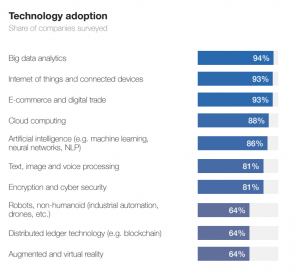
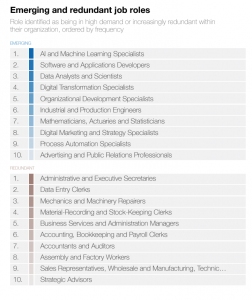
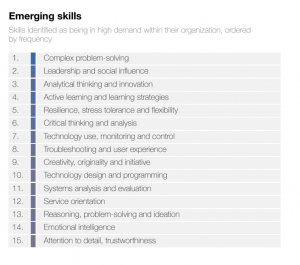
The driving force is to use the power of human ingenuity in the purest points of problem-solving to continue to expand labor markets past the reach of AI. And more, to grow alongside it.
Impact of COVID-19 on jobs
Predictions show that humanity has been digressing into an unemployment epidemic as more and more jobs have been replaced with Artificial Intelligence (AI) over the past decade. However, the current pandemic caused an immediate and sudden spike in joblessness across several key economies—expediting a reliance on tech in an unemployed world. Early evidence from Figure 5 in the WEF’s report suggests that, in addition to the labor market displacement caused by this health shock, employers are set to accelerate their job automation and augmentation agenda.
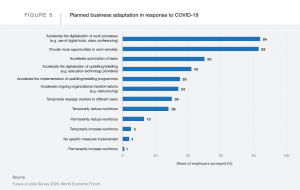
“As a result of the twin forces acting on the Fourth Industrial Revolution and the COVID-19 recession, day-to-day digitalization has leapt forward, with a large-scale shift to remote working and e-commerce, driving a surge in work-from-home arrangements and a new marketplace for remote work. However, it has also brought about significant well-being challenges as workers have struggled to adapt to new ways of work over a short period of time”
The individuals and communities most affected by the unprecedented changes brought about by COVID-19 are likely to be those which are already most disadvantaged—living in neighborhoods with poor infrastructure, who have poor employment prospects, and whose income does not equip them with a comfortable living standard, healthcare coverage or savings.
Awareness of these challenges intersected with compounding reasons for lack of access is the first step to responding to this crisis. Cognizance of how we can think critically beyond these problems and within our own communities, companies, and countries, will allow us to make true, systematic change that allows humans all over the world to triumph beyond AI in this Fourth Industrial Revolution.
Forecasts of the resurgence of the labor force with AI
Over the past five years, the World Economic Forum has tracked the arrival of the future of work, identifying the potential scale of worker displacement due to technological advancements alongside effective strategies for empowering job transitions from declining to emerging jobs.
The past two years have seen a clear acceleration in the adoption of new technologies among the companies surveyed. Figure 18 presents a selection of technologies organized according to companies’ likelihood to adopt them by 2025.
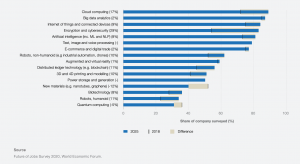
“Cloud computing, big data, and e-commerce remain high priorities, following a trend established in previous years. However, there has also been a significant rise in interest in encryption, reflecting the new vulnerabilities of our digital age, and a significant increase in the number of firms expecting to adopt non humanoid robots and artificial intelligence, with both technologies slowly becoming a mainstay of work across industries.”
Recognizing this shift from computation and towards one of analysis and artistry is beneficial for employees and employers alike. Again, use this to be cognizant when strategizing your career path and your employees as well. Invest in jobs proving increasing demand here and structure your company accordingly.
Solutions to help you address these challenges within our Saudi community
The challenges facing labor markets today are significant but not insurmountable. To jointly lead economies and societies to greater prosperity, the public and private sector will need to tackle the factors that lead to the misallocation and waste of human capabilities and potential.
“To harness human potential towards greater prosperity and inclusion, leaders will need to shift talent from areas of decline to areas of growth in the economy.”
This report calls for renewed efforts to understand the division of spending on reskilling and upskilling workers between business and the public sector. The public sector specifically needs to step up to fund efforts that retrain and re-skill people who are mid-way through their careers and need to pivot to match this moment. Policies that act here will ensure that workers are able to create cash reserves during periods of employment, and policies that legislate against bias in hiring, firing, and setting wages.
This resurgence comes with a focus from temporary public policy relief to long term solutions; from deploying human resources to leveraging human potential.
In this new context, for the first time in recent years, job creation is starting to lag behind job destruction—and this factor is poised to affect disadvantaged workers with particular ferocity. Businesses are set to accelerate the digitalization of work processes, learning, expansion of remote work, as well as the automation of tasks within an organization. This report identifies one result of the pandemic as an increasing urgency to address the disruption underway both by supporting and retraining displaced workers and by monitoring the emergence of new opportunities in the labor market.
Addressing the current challenges posed by COVID-19, in tandem with the disruption posed by technological change, requires renewed public service innovation for the benefit of affected workers everywhere. It also demands that leaders embrace stakeholder capitalism and pay closer attention to the long-dividends of investing in human and social capital.
The current moment provides an opportunity for leaders in business, government, and public policy to focus common efforts on improving the access and delivery of reskilling and upskilling, motivating redeployment and reemployment, as well as signaling the market value of learning that can be delivered through education technology at scale.
Again, this report said it’s time to unleash humanity’s technological innovations to propel us all beyond this global impact of COVID-19 on jobs, and here at Mukatafa, we are ready to help you match the moment.
